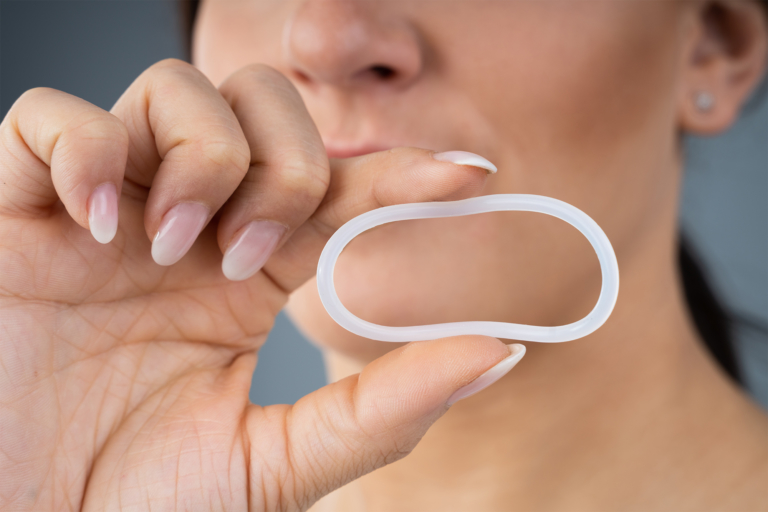An increasing number of women are turning to menstrual charting apps for health management or to try natural forms of family planning. In a 2018 Cosmo survey, 70 percent of young women said they’d either stopped taking the Pill or had considered doing so in the past three years. It would appear that birth control is starting to get a bad rap for undesirable side effects.
The switch from synthetic hormones or devices to natural forms of birth control is becoming a popular choice, as researchers estimate some 200 million women are now using charting apps. Even the development of the recent copper IUD seems to be in response to women’s desires for a nonhormonal form of birth control to ditch the undesirable side effects of synthetic hormones (unfortunately, the copper IUD brings its own negative effects). But frustrating side effects aren’t a new thing for women taking birth control, unfortunately. Sadly, they’ve been a huge problem with pharmaceutical contraceptives from their earliest beginnings.
1970
When we think of the ‘70s and birth control, it may bring up thoughts of sexual liberation and women’s freedom to choose their family size. So you might be surprised to hear this account from author Mike Gaskins, published at Hormone Matters, describing the biggest event in the United States surrounding birth control:
“Fifty years ago . . . a vibrant group of young women put on their best dresses and placed themselves strategically around the senate gallery. They were eager to disrupt and ready to make some noise but had no idea the impact they were about to make on the course of history. They were attending the opening statements of a controversial look at hormonal birth control that would later become known as the Nelson Pill Hearings.
“In 1970, hormonal birth control had been on the market for almost a decade. Although 8.5 million women were already taking The Pill, serious questions about its safety were just coming to the surface. Senator Gaylord Nelson chaired an explosive Congressional committee that set out to answer two simple questions: Has the safety of hormonal contraceptives been established? Are women being given sufficient information about the verified risks?”
As Gaskins, author of the 2019 book In the Name of the Pill, describes the Nelson Pill Hearings, “the committee examined a vast range of issues in the drug industry (most of which are ripe for revisiting today), including questionable pricing practices, deceptive advertising, safety and efficacy of over-the-counter products, generics versus name brands, and a lack of regulation on medical devices.”
It all began when feminist writer Barbara Seaman sent a copy of her book, A Doctors’ Case Against the Pill to Senator Gaylord Nelson, which led him to direct his committee to investigate whether oral contraceptives had been proven safe. The Pill had been on the market for a decade at this point, and 8.5 million women were already taking it.
How did the Pill get on the market with so many women experiencing troubling side effects? Gaskins explains in “A Short History of Birth Control’s Controversial Past” at Natural Womanhood:
“A few doctors at the hearings also explained how it was that such a potent drug could be pushed through the approval process with inadequate testing. Fears of a global population explosion led evaluators to change the benefit-to-risk paradigm to approve this drug. Rather than compare the benefit and risk for the patient, they looked at the benefit to society (reducing population growth) versus the risk to the individual woman.”
Katherine McCormick, heiress to the International Harvester fortune, funded the work of Dr. Gregory Pinccus, who was researching the effects of the synthetic hormone progestin on animals. Because of the difficulties in retaining patients for human studies (precisely because the side effects were so terrible), McCormick famously said, “[we need a] cage of ovulating females to experiment with,” to make a birth-control drug a reality. That happened with the first birth control pill Enovid in 1955, when Pinccus’s team experimented on poor women in Puerto Rico without informing the women about possible side effects from the under-researched drug. The drug was found to be effective in preventing pregnancy, but it wasn’t safe for the women taking it. Nevertheless, it was approved by the FDA. As Gaskins says:
“The regulatory environment had been quite lax. It later came to light that no real control group had been established for the Puerto Rico trial. Five women died during the trial, including a suicide. All were buried without autopsies, and none of the deaths were reported or attributed to the Pill.”
Gaskins explains further, “While looking into ineptitude at the FDA in 1964, Sen. Hubert Humphrey discovered that the trial had been based on only 132 women for 12 consecutive months. Morton Mintz of the Washington Post reported this as a ‘scientific scandal… For one thing, 132 is a smaller number of women than, this year alone, will die from clotting induced by the Pill.’”
Birth control-related deaths continue to this day
In a 2019 article published at Public Discourse, UCLA researcher Dr. Lynn Keenan and Natural Womanhood CEO Gerard Migeon published an article finding that 300-400 U.S. women die annually of cardiovascular events caused by the birth control they’re taking:
Our systematic review of the scientific literature led us to conclude that, in the United States, 136 to 260 healthy women die from VTE caused by hormonal contraception every year. When that risk is combined with the added risk of stroke and heart attack, between three and four hundred women die every year in the United States due to their choice to use hormonal contraception. To give some perspective, meningitis killed 45 people (of all ages) in 2017. Most states in the US mandate meningitis vaccination for college and university students. Would they consider the same kind of prevention campaigns for the deadly blood clots caused by hormonal birth control?
Despite these high death rates, many women say they were not made aware of the side effects they faced in taking hormonal contraception, including near-death experiences, until they were hospitalized. In a Citizen’s Petition filed to the FDA in 2019 for greater transparency on birth control prescriptions, which was filed along with more than 100 pages of research on birth control side effects and health complications, numerous people commented sharing experiences they or their loved ones had faced. Some women shared near-death experiences of making it to the hospital in time with a blood clot; other tragic accounts are written by parents whose daughters suddenly collapsed and died, seemingly without warning.
Read for yourself some of the accounts people have shared since the comments opened in 2019:
“Last year, at the age of 46, I was hospitalized with a cerebral thrombosis that was literally caught right before causing a stroke. The ER docs told me that if it had not been for the fact that the people I was with at the time of the event were trained to recognize the signs of stroke and called 911 for a stroke paramedic unit that arrived quickly, I would have been somewhere between a vegetative state and severely disabled. After countless CT scans and MRIs, along with a thorough study of my family history, the neurologist and hematologist teams determined it was the Oral Contraceptives that I was taking that had caused the thrombosis.”
“2 years ago, my daughter died from a blood clot in her brain caused by the birth control, Yasmin. It was prescribed to her for acne and she believed it was safe. She had no risk factors, no clotting disorders. In the hospital, the doctors told us they see 3-5 patients EVERY WEEK with blood clots from birth control. That’s one hospital in a small metropolitan area in Wisconsin. I can’t imagine what other hospitals are experiencing. Unfortunately, in the last 2 years, I have met several other mothers who lost their daughters to birth control and many others who almost did. Yasmin is still on the market. WHY?!? So many of these contraceptives need to be removed from the market and further studies need to be done. There needs to be SAFE options for women.”
“We lost our 23 year old daughter Alexandra to MPE caused by Lutera. She was on it for six months and dropped dead with no warning.”
“Our daughter died at age 29 in the Intensive Care Unit of her local hospital where she had been transferred after presenting herself at her local walk-in clinic. Her death was five weeks to the day after getting married and one day before scheduled departure on a delayed honeymoon cruise. The autopsy report stated that she had “bilateral pulmonary thromboemboli” with a thrombus present in the left popliteal fossa. She had been using Nuvaring at the time of her death, this had been removed at the walk-in clinic prior to transport to the hospital. In discussion following her death with the ICU doctor who had directed her treatment, the doctor stated that she believes that hormonal birth control was a significant contributor to the death of our daughter.”
“My daughter died at the age of 29 due to massive bilateral pulmonary embolisms while using NuvaRing as her birth control. I don’t think women are aware of the many problems that can and do happen with hormonal birth control. Physicians continually reassure women that these products are ‘safe’ when in fact they can cause changes in a woman’s body and can and do lead to health issues, including life threatening blood clots.”
“I almost died 5 days before my 27th birthday…” Read Amanda’s entire harrowing story here.
“My neighbor suffered from a life threatening blood clot. She was a young mother, healthy, thin and a nonsmoker. Her physician immediately took her off of oral contraceptives, informing her that this was the cause and she could never take them again. She was angry that she had never been adequately informed of this possibility.”
“What I didn’t know or have any clue of, was that my decision months earlier to begin taking birth control was the reason I needed to go to the hospital that day. My birth control that I received under the table, was threatening my life, and I thought it was protecting me. The doctors found hundreds of blood clots filling my lungs and chest tubes, and my heart was enlarged because of the built up pressure caused by the blood-clots …” Read this woman’s full story here.
“I had a deep vein clot in my left forearm directly linked to my use of the vaginal ring; the clot developed after a surgery and an extended IV in my left arm. My only knowledge of blood clots and birth control was that smoking increased the risk of blood clots while on birth control; I am not a smoker. I also experienced severe mood swings and depression, and weight gain, on depo-provera, these symptoms being down-played by my doctor as normal during the use of birth control.”
For far too long, women’s negative experiences with birth control have not been taken seriously, and modern women continue to be prescribed the drugs with little more warning than those given to our foremothers. It’s time for us to shed light on the realities women are enduring, so other women in similar situations feel more affirmed and less alone. Sharing our experiences with other women has a very empowering—and potentially lifesaving—effect for ourselves and others.
Mary Rose Somarriba is editor of Natural Womanhood.




